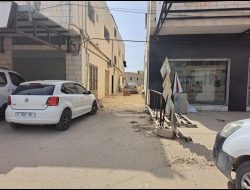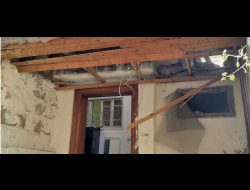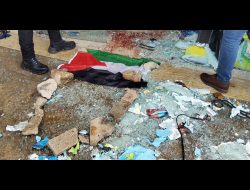
Qusai al-‘Amur. Photo courtesy of the family
On 16 January 2017, at about 3:45 P.M., a Border Police officer fatally shot Qusai Hassan Muhammad al-‘Amur, 17, a resident of the town of Tuqu’, Bethlehem District. He fired four 0.22-inch caliber bullets at al-‘Amur. During the hour and a half preceding the shooting, young Tuqu’ residents threw stones at Israeli security forces who were standing at the entrance to the town. The security forces fired rubber-coated metal bullets and tear gas and threw stun grenades at the youths. The stone-throwing abated and only three youths, who had taken shelter among olive trees, remained on the scene and threw a few stones at the security forces. It was at this point in time that the Border Police officer fatally shot Qusai al-‘Amur. Video footage published in the media shows soldiers and Border Police officers running over to al-‘Amur as he lay wounded on the ground, seizing him violently, and dragging him away by his arms and legs, with his head and back repeatedly knocking against the ground.
At about 2:30 P.M. on 16 January 2017 seven Israeli security service vehicles entered the Palestinian town of Tuqu’ which lies south of Bethlehem. The vehicles drove out of the town shortly thereafter, but six remained at the entrance, some 80-100 meters from olive groves and the adjacent municipality building. About ten youths and teenagers, some masked, gathered in the area of the olive grove and the road beside it. They began throwing stones at the Israeli security personnel who were standing by the jeeps. The soldiers and Border Police officers fired rubber-coated metal bullets and tear gas at the youths and also threw stun grenades at them.
Over an hour later, at about 3:45 P.M., the clashes subsided. Two of the military jeeps advanced a few meters, and a group of soldiers and Border Police officers, including two snipers armed with Ruger rifles, took up positions behind and in the vehicles.
Hisham Abu Shaqrah, a photojournalist with the Turkish Anadolu Agency, began filming the clashes from about 3:00 P.M. from a spot near the olive grove. He recounted the events he saw to B’Tselem field researcher Musa Abu Hashhash:
Most of them ran away and three masked youths remained under the olive trees. One of them sat down facing the soldiers. Suddenly I heard gunfire, the sound of four bullets being fired by a sniper from the spot where the soldiers were standing. I quickly turned my camera toward the olive trees where the masked youths were. I saw that the youth who had been sitting up had fallen down, and several soldiers were running toward him. When they reached him they picked him up violently. I filmed them dragging him by his arms and taking him over to the military vehicles. As they dragged him, his body bumped along the ground.
Taysir Abu Mfareh, 47, a resident of Tuqu’ and the administrative director of the Tuqu’ Municipal Council, was standing close to the municipality building at the time of the shooting. In testimony taken by B'Tselem field researcher Musa Abu Hashhash, Abu Mfareh described the shooting:
Most of the youths ran off. Three guys, including al-‘Amur, moved over to the olive grove, about 80 meters away from the soldiers. Things were much calmer. I looked at the soldiers and at the youths, who threw a few stones at the soldiers every few minutes. I thought that the clashes were just about over. Suddenly I saw a soldier behind a military vehicle shoot toward the olive trees, and I heard gunfire, not loud but several bullets in quick succession. Several soldiers rushed toward the olive trees, running until they reached the injured youth. A few soldiers picked him up and ran with him toward the military jeeps, his back hitting the ground. The soldiers put him down behind a military jeep, and one of them tried to give him first aid.
A few minutes after the soldiers evacuated al-‘Amur, several dozen local residents came to the area and attempted to approach the military jeeps. Among the residents was al-‘Amur’s 39-year-old sister Hiyam. The soldiers called out to the residents to keep back, and fired tear gas and other crowd control measures. They also fired live ammunition into the air and threw stun grenades. The video clip documenting the incident also shows a soldier firing at Hiyam al-‘Amur’s leg as she stood about 10 meters away from him, and immediately thereafter shooting in the leg another youth who came to help her.
A few minutes later, the soldiers carried al-‘Amur to another military jeep parked a few meters further back. They laid him on a stretcher and put him in the jeep. The military vehicles began to drive away from the town entrance, and the youths threw stones at them. They also threw a Molotov cocktail that hit one of the jeeps. Some of the soldiers fired live bullets into the air, fired rubber-coated metal bullets and threw stun grenade. Another youth was injured by crowd control measures during the clashes. Some 20 minutes later, at the main intersection at the entrance to Tuqu’, al-‘Amur was transferred to an Israeli ambulance that evacuated him from the scene.
Between 5:30 and 6:00 P.M., al-‘Amur’s body was transferred to hospital in Beit Jala, where an autopsy was performed. The autopsy report located four bullet entry wounds, two of which caused severe bleeding in his thoracic cavity.
The IDF Spokesperson released a statement that “during a violent disturbance involving some 200 Palestinians in the village of Tuqu’, which included the throwing of stones and Molotov cocktails at the security forces, a Border Police combatant responded by firing at one of the disturbers of the peace”. According to media reports, the Military Police Investigations Unit and the Israel Police have opened an investigation.
However, B'Tselem’s investigation shows that this version of events has no basis in reality. Prior to the shooting of al-‘Amur, the clashes in Tuqu’ included only stone throwing at the security forces by some 10 youths. Even these clashes had practically stopped when the Border Police officer shot and killed al-‘Amur. The investigation also shows that al-‘Amur and his friends were at a distance of 80 to 100 meters from the security forces, so they did not constitute any danger. In these circumstances, the shooting of al-‘Amur was clearly unjustified and unlawful. Moreover, the brutal manner in which the soldiers evacuated al-‘Amur after he had been injured, his head and back banging on the ground, reflects their profound disregard for his life.
Al-‘Amur was killed by 0.22 inch caliber bullets. The open-fire regulations for the use of such bullets are strict, and confine their use to cases of mortal danger, similar to the use of live ammunition. Over the past two years, however, the military has almost routinely used these bullets as a means of crowd control, even when the troops on the ground are not in mortal danger. Over the past two years, this policy has led to the deaths of six Palestinians (including al-‘Amur) and to hundreds of injuries, some severe.
- Update: On 22 July 2018, human rights orgaization Yesh Din was informed that the case had been closed without an indictment.


